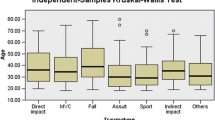Abstract
Background
Head CT scans are considered the imaging modality of choice to screen patients with head trauma for neurocranial injuries; however, widespread CT imaging is not recommended and much research has been conducted to establish objective clinical predictors of intracranial injury (ICI) in order to optimize the use of neuroimaging in children with minor head trauma.
Objective
To evaluate whether a strict application of the New Orleans Criteria (NOC), Canadian CT Head Rule (CCHR) and National Emergency X-Radiography Utilization Study II (NEXUS II) in pediatric patients with head trauma presenting to a non-trauma center (level II) could reduce the number of cranial CT scans performed without missing clinically significant ICI.
Materials and methods
We conducted an IRB-approved retrospective analysis of pediatric patients with head trauma who received a cranial CT scan between Jan. 1, 2001, and Sept. 1, 2008, and identified which patients would have required a scan based on the criteria of the above listed decision instruments. We then determined the sensitivities, specificities and negative predictive values of these aids.
Results
In our cohort of 2,101 patients, 92 (4.4%) had positive head CT findings. The sensitivities for the NOC, CCHR and NEXUS II were 96.7% (95%CI 93.1–100), 65.2% (95%CI 55.5–74.9) and 78.3% (95%CI 69.9–86.7), respectively, and their negative predictive values were 98.7%, 97.6% and 97.2%, respectively. In contrast, the specificities for these aids were 11.2% (95%CI 9.8–12.6), 64.2% (95%CI 62.1–66.3) and 34.2% (95%CI 32.1–36.3), respectively. Therefore, in our population it would have been possible to scan at least 10.9% fewer patients.
Conclusions
The number of cranial CT scans conducted in our pediatric cohort with head trauma would have been reduced had any of the three clinical decision aids been applied. Therefore, we recommend that further validation and adoption of pediatric head CT decision aids in non-trauma centers be considered to ultimately increase patient safety while reducing medical expense.

Similar content being viewed by others
References
Langlois JA, Rutland-Brown W, Thomas KE (2004) Traumatic brain injury in the United States: emergency department visits, hospitalizations, and deaths. Atlanta (GA): Centers for Disease Control and Prevention National Center for Injury Prevention and Control Web Site. Available via http://www.cdc.gov/ncipc/pub-res/TBI_in_US_04/TBI_ED.htm. Accessed 04 Feb 2011
Stiell IG, Wells GA, Vandemheen K et al (2001) The Canadian CT Head Rule for patients with minor head injury. Lancet 357:1391–1396
Centers for Disease Control and Prevention National Center for Injury Prevention and Control (2003) Report to Congress on mild traumatic brain injury in the United States: steps to prevent a serious public health problem. Atlanta (GA): Centers for Disease Control and Prevention. Available via www.cdc.gov/ncipc/pub-res/mtbi/mtbireport.pdf. Accessed 04 Feb 2011
Quayle KS, Jaffe DM, Kuppermann N et al (1997) Diagnostic testing for acute head injury in children: when are head computed tomography and skull radiographs indicated? Pediatrics 99:e11
Klauber MR, Marshall LF, Luerssen TG et al (1989) Determinants of head injury mortality: importance of the low risk patient. Neurosurgery 24:31–36
Schunk JE, Rodgerson JD, Woodward GA (1996) The utility of head computed tomographic scanning in pediatric patients with normal neurologic examination in the emergency department. Pediatr Emerg Care 12:160–165
Livingston DH, Lavery RF, Passannante MR et al (2000) Emergency department discharge of patients with a negative cranial computed tomography scan after minimal head injury. Ann Surg 232:126–132
Blackwell CD, Gorelick M, Holmes JF et al (2007) Pediatric head trauma: changes in use of computed tomography in emergency departments in the United States over time. Ann Emerg Med 49:320–324
National Center for Health Statistics Centers for Disease Control and Prevention (2002) Emergency Department File. National Hospital Ambulatory Medical Care Survey. Available at: http://www.cdc.gov/nchs/products/elec_prods/subject/nhamcs.htm. Accessed 04 Feb 2011
Brenner DJ, Hall EJ (2007) Computed tomography—an increasing source of radiation exposure. N Engl J Med 357:2277–2284
Jagoda AS, Cantrill SV, Wears RL et al (2002) Clinical Policy: neuroimaging and decision making in adult mild traumatic brain injury in the acute setting. Ann Emerg Med 40:231–249
Marik PE, Varon J, Trask T (2002) Management of head trauma. Chest 122:699–711
Shackford SR, Wald SL, Ross SE et al (1993) The clinical utility of computed tomographic scanning and neurologic examination in the management of patients with minor head injuries. J Trauma 35:490–491
Haydel MJ, Preston CA, Mills TJ et al (2000) Indications for computed tomography in patients with minor head injury. N Engl J Med 343:100–105
Smits M, Dippel DWJ, de Haan GG et al (2005) External validation of the Canadian CT Head Rule and the New Orleans Criteria for CT scanning in patients with minor head injury. JAMA 294:1519–1525
Mower WR, Hoffman JR, Herbert M et al (2005) Developing a decision instrument to guide computed tomographic imaging of blunt head injury patients. J Trauma 59:954–959
Oman JA, Cooper RJ, Holmes JF et al (2006) Performance of a decision rule to predict need for computed tomography among children with blunt head trauma. Pediatrics 117:e238–e246
Kuppermann N, Holmes JF, Dayan PS et al (2009) Identification of children at very low risk of clinically-important brain injuries after head trauma: a prospective study. Lancet 374:1160–1170
Osmond MH, Klassen TP, Wells GA et al (2010) CATCH: a clinical decision rule for the use of computed tomography in children with minor head injury. CMAJ 182:341–348
Schutzman SA, Greenes DS (2001) Pediatric minor head trauma. Ann Emerg Med 37:65–74
Greenes DS, Schutzman SA (1999) Clinical indicators of intracranial injury in head-injured infants. Pediatrics 104:861–867
Author information
Authors and Affiliations
Corresponding author
Rights and permissions
About this article
Cite this article
Schachar, J.L., Zampolin, R.L., Miller, T.S. et al. External validation of the New Orleans Criteria (NOC), the Canadian CT Head Rule (CCHR) and the National Emergency X-Radiography Utilization Study II (NEXUS II) for CT scanning in pediatric patients with minor head injury in a non-trauma center. Pediatr Radiol 41, 971–979 (2011). https://doi.org/10.1007/s00247-011-2032-4
Received:
Revised:
Accepted:
Published:
Issue Date:
DOI: https://doi.org/10.1007/s00247-011-2032-4




